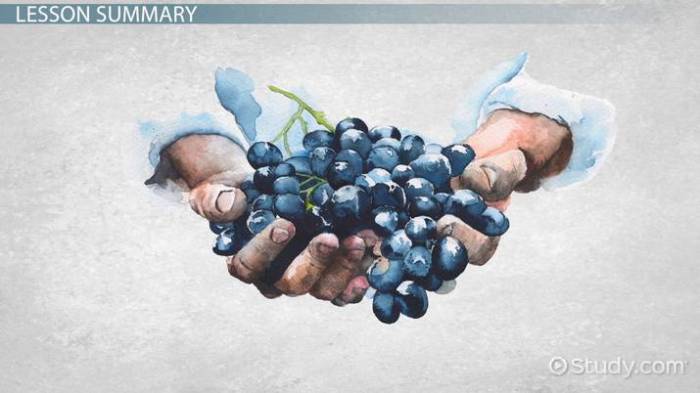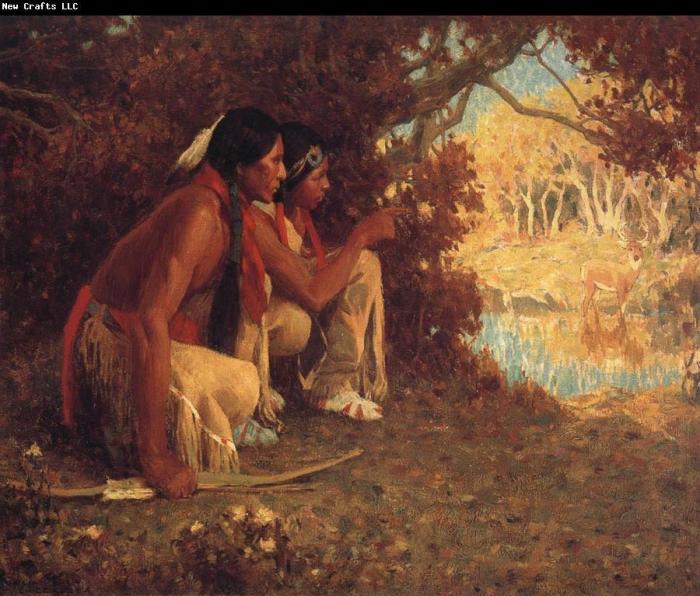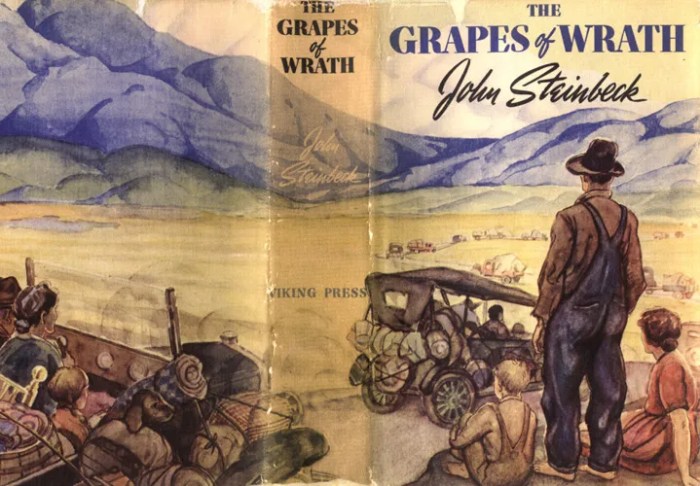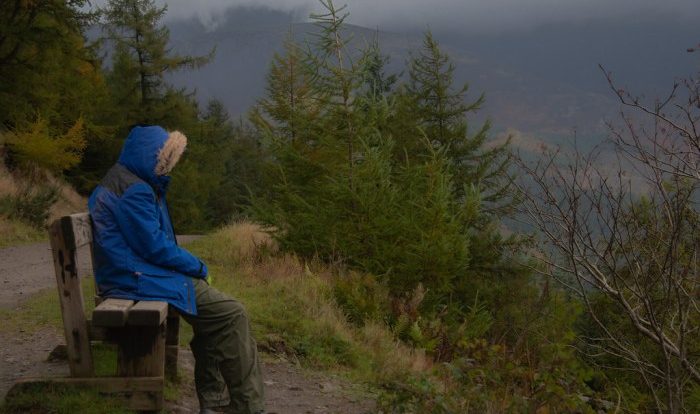Grapes of wrath chapter 9 – Embark on a journey into Chapter 9 of John Steinbeck’s Grapes of Wrath, where we delve into the Joad family’s arduous experiences during the Great Depression and Dust Bowl. Through the lens of engaging characters, powerful symbolism, and thought-provoking themes, this chapter offers a poignant exploration of hope and despair amidst economic hardship.
As the Joads navigate the challenges of Hoovervilles and labor camps, their interactions with the Wilsons and Wainwrights shed light on the struggles and resilience of migrant workers. Steinbeck’s skillful use of foreshadowing and symbolism weaves a tapestry of hope and despair, leaving readers to ponder the complexities of the human condition.
Character Development

In Chapter 9 of “The Grapes of Wrath,” the Joad family’s encounters with the Wilsons and the Wainwrights offer profound insights into the characters’ development and the challenges faced by migrant workers during the Great Depression.
The Wilsons, a family of farmers, embody the struggle of small landowners against the relentless forces of economic hardship. Their eviction and subsequent journey parallel the Joads’ own experiences, highlighting the widespread displacement and poverty that plagued rural America.
Tom Joad’s Evolving Role
Tom Joad emerges as a central figure in this chapter. His transformation from a restless wanderer to a committed advocate for the downtrodden is evident in his interactions with the Wilsons and the Wainwrights.
Through his conversations with the Wilsons, Tom develops a deep understanding of the systemic injustices faced by farmers. He recognizes the need for collective action and becomes a catalyst for organizing the migrant workers.
Al and Aggie Wainwright
Al and Aggie Wainwright, a young couple struggling to make ends meet, represent the plight of the most vulnerable migrant workers. Their desperate search for work and their constant fear of starvation reflect the harsh realities of life on the road.
Aggie’s pregnancy and Al’s injury serve as poignant reminders of the physical and emotional toll that the migrant lifestyle takes on individuals and families.
Setting and Symbolism: Grapes Of Wrath Chapter 9

The title “Grapes of Wrath” carries profound symbolism throughout the novel. Grapes, often associated with abundance and prosperity, stand in stark contrast to the struggles and poverty endured by the Joads and countless other migrant workers during the Great Depression.
The “wrath” suggests the anger and desperation that fuel their journey, as well as the wrath of nature that relentlessly batters their spirits.
Significance of the Setting
Chapter 9 vividly depicts the bleak conditions of the Hoovervilles and labor camps that become temporary homes for the Joads. Hoovervilles, shantytowns constructed by homeless migrants, symbolize the failure of the government to provide adequate support during the economic crisis.
Labor camps, where migrants toil for meager wages under harsh conditions, represent the exploitation and oppression they face.
Influence of Natural Elements
The natural elements in Chapter 9 play a significant role in shaping the characters’ lives. Dust storms, a recurring motif in the novel, symbolize the relentless hardships that the Joads encounter. They obscure visibility, suffocate, and erode both the land and the human spirit.
The harsh sun beats down mercilessly, symbolizing the oppressive forces that weigh heavily on the migrants.
Themes

Chapter 9 of The Grapes of Wrathdelves into several profound themes that are central to the novel’s narrative.
The chapter poignantly explores the theme of economic inequality, laying bare the stark disparities between the wealthy landowners and the impoverished migrant workers.
Economic Inequality, Grapes of wrath chapter 9
- The chapter vividly portrays the Joad family’s struggle to find work and earn a decent living amidst the harsh realities of the Dust Bowl.
- The landowners, such as the Wilsons, exploit the desperation of the migrant workers, paying them meager wages and providing them with substandard living conditions.
- This economic inequality creates a deep sense of resentment and frustration among the workers, fueling the growing tensions between them and the landowners.
Furthermore, the chapter explores the theme of family and community, emphasizing the importance of these bonds in the face of adversity.
Family and Community
- The Joad family serves as a testament to the resilience of the human spirit, as they face countless challenges together and find strength in their unwavering support for one another.
- The migrant worker community also provides a sense of belonging and solidarity for the Joads, as they share their experiences and struggles.
- However, the chapter also highlights the challenges that families and communities face when confronted with poverty and discrimination.
Lastly, the chapter delves into the theme of hope and despair, exploring the characters’ inner struggles as they navigate the harsh realities of their situation.
Hope and Despair
- Despite the overwhelming challenges they face, the Joads and other migrant workers cling to a flicker of hope, driven by their dreams of a better future.
- However, the chapter also acknowledges the despair that can consume individuals when their hopes are repeatedly dashed.
- The characters’ actions and interactions reveal the complex interplay between hope and despair, as they struggle to find a balance between resilience and resignation.
Narrative Techniques

In Chapter 9, Steinbeck employs various narrative techniques to enhance the chapter’s impact and convey its themes. These techniques include foreshadowing, symbolism, and a carefully structured organization.
The harsh realities depicted in Chapter 9 of “The Grapes of Wrath” highlight the systemic failures that plagued the working class during the Great Depression. This chapter serves as a poignant reminder of the importance of economic policies that prioritize social justice.
For a deeper understanding of the macroeconomic principles at play, I highly recommend exploring the fiveable ap macro unit 4 resource, which provides comprehensive coverage of topics such as fiscal and monetary policy, inflation, and economic growth. By examining the events in Chapter 9 through the lens of these macroeconomic concepts, we can gain valuable insights into the complexities of economic inequality and its impact on individuals and communities.
Foreshadowing
Steinbeck uses foreshadowing to hint at future events and create a sense of anticipation. For instance, the description of the “lean and hungry” men at the Hooverville camp foreshadows the desperation and hardship that the Joads will encounter as they continue their journey.
Symbolism
Steinbeck employs symbolism throughout the chapter to convey deeper meanings and emotions. The dust, for example, symbolizes the oppressive conditions that the migrants face, while the turtle represents the slow and arduous progress of their journey.
Structure and Organization
The chapter’s structure is significant as it mirrors the Joads’ journey. The first part of the chapter focuses on the Hooverville camp, representing their initial struggles and disappointments. The second part depicts their departure from the camp and their encounter with the turtle, symbolizing their determination and hope.
Language and Imagery
Steinbeck’s language and imagery contribute to the chapter’s overall impact. The use of vivid descriptions and sensory details immerses the reader in the characters’ experiences. For example, the description of the “stinking” and “swarming” conditions at the camp conveys the harsh realities faced by the migrants.
Historical Context

Chapter 9 of “The Grapes of Wrath” captures the devastating effects of the Great Depression and the Dust Bowl on the lives of migrant farmworkers. The Great Depression, a severe economic crisis that began in 1929, led to widespread unemployment, poverty, and homelessness across the United States.
The Dust Bowl, a prolonged drought that affected the Great Plains from 1930 to 1939, further exacerbated the economic hardship, forcing many farmers to abandon their land and seek work elsewhere.
Social and Economic Conditions
The chapter vividly portrays the social and economic conditions faced by migrant farmworkers during this period. The Joad family, like countless others, is forced to leave their home in Oklahoma and travel west in search of work. Along the way, they encounter extreme poverty, discrimination, and exploitation.
The camps where they live are overcrowded and unsanitary, and the wages they earn are meager.
Contemporary Relevance
The chapter remains relevant today, as it sheds light on the challenges faced by low-income families and migrant workers. Poverty and migration continue to be pressing issues in the 21st century, and the experiences of the Joad family resonate with those who struggle to make ends meet and find a place to call home.
FAQ Compilation
What is the significance of the “Grapes of Wrath” symbol in Chapter 9?
The “Grapes of Wrath” symbolize both the promise of a better life and the harsh realities faced by migrant workers. The Joads’ journey towards California, the “promised land,” is paralleled with the biblical story of Moses leading the Israelites out of slavery towards the “land of milk and honey.”
How does Tom Joad’s role evolve within the family in Chapter 9?
Tom emerges as a leader and protector within the Joad family. He stands up for his family’s rights, challenges authority, and becomes a symbol of hope and resistance.
What is the significance of the setting in Chapter 9?
The Hoovervilles and labor camps represent the harsh conditions faced by migrant workers. These settings highlight the lack of sanitation, overcrowding, and exploitation that migrant workers endured.

